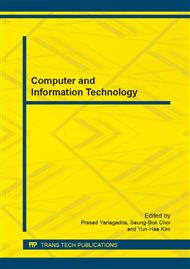p.164
p.170
p.177
p.181
p.185
p.189
p.193
p.197
p.202
An Authentication Scheme Based on the Light-Weight Rainbow Signature for Wireless Sensor Network
Abstract:
Based on the rainbow signature scheme and combining the minus perturbation method of the Shamir, a new light-weight rainbow signature scheme is proposed. This scheme only uses the addition and multiplication operation, so it can be performed easily. This scheme has high security and can resist the minimal rank, rank reduction attacks and oil-vinegar attacks, etc. Based new signature scheme, we also design authentication mechanism for the WSN. According to the characters of the cluster WSN, this authentication mechanism can choose proper authentication parameters to realize the authentication on the cluster WSN by the platform and the authentication between the sensor node and its neighbor nodes.
Info:
Periodical:
Pages:
185-188
Citation:
Online since:
February 2014
Authors:
Price:
Сopyright:
© 2014 Trans Tech Publications Ltd. All Rights Reserved
Share:
Citation:


